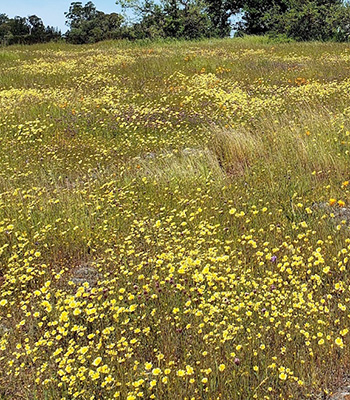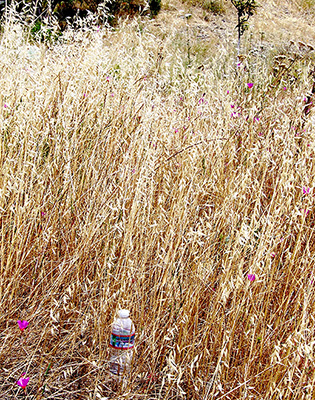A Special Presentation Given by Craig Dremann of EcoSeeds.com
And a Project for Our Community
Please note that this is a "work in progress." Our Fire Department, the WFPD, only endorses the monthly mowing portion of the program at this time. Beginning in February, or when grasses have grown to be over 8 inches tall, mow (weed-whack) the tops off at 8 to 12 inches. Then do that monthly until the grasses stop growing. This keeps their seeds from maturing, and gives the wildflower seeds that are present in the top layers of soil a chance to thrive. When we mow near the ground, we kill the wildflowers along with the grasses.
We hope that we will be able to do some "test plots" over the next year or two, to get a better idea of the usefulness of the entire program for our environment, long-term. Many questions remain open. But there is no question that an acre of weed grasses that are simply mowed to the ground can represent over a ton of fuel for fires to spread!
At the WPV-Ready meeting in February of 2023, we were lucky to have a presentation by Craig Dremann of EcoSeeds.com. Craig has been working for decades in our local environment to figure out how we ended up with such a flammable landscape, and what can be done about it. You can reach Craig at craig@ecoseeds.com. And you can find a huge variety of heirloom seeds on his website, http://EcoSeeds.com, where he has also posted some of the files we will describe below, to help us make our own "Weeds to Wildflowers" plans.
Below is what Craig sent us, summarizing his approach and findings, and helping us figure out how to put this to work around us. Most of this material was taken from some email conversations we had with Craig before and after his presentation. There is also a recording of his entire presentation. The YouTube link is at the bottom.
The basic idea is this: What we see in most of our open spaces is "weed grasses." They grow tall then turn into highly flammable fuel at a typical rate of tons per acre. But in the soil there is a "seed bank" of wildflower seeds just waiting to be released. The problem is twofold. They are crowded out by the weed grasses, and the soil has been depleted of some of the nutrients they need. This has happened due to a number of factors, starting with a state-wide drought in the 1800s that caused California's large cattle herds to eat most of the wildflowers to the ground.
The good news is, those wildflower species are typically much less flammable, AND they can be brought back with a little care. Once they are re-established in an area, they are tougher than the weed grasses, so they remain and keep the more flammable weed grasses mostly suppressed. And it can look like this picture of Kite Hill taken a couple of years ago. This did not take a huge effort. Notice the lack of flammable grasses!
If we all work together as a team, we can restore most of our area to these much safer and more beautiful scenes in just 2 or 3 years.
The broad approach is simple. Stop the weed grasses from dropping their seeds by mowing their tops off, and restore the vital nutrients that are now missing from the soil. The results begin to be seen in the first year.
Below we see the Kit Hill Wildflower Preserve in Woodside, and the Wild Oats that used to control the landscape before it was restored with the "Weeds to Wildflowers" process.


Let's get started!
| 1 |
|
Start monthly mowing at the end of February. As many of the local home owners that have any weed grasses sprouting up right now, get your gardeners organized by the end of February to start the monthly mowing at 8-12 inches high and no lower. |
| |
|
|
| 2 |
|
Open space monthly mowing at 8-12 inches high. The Towns, County, and other entities that control open lands can get organized by the end of February, to start mowing its Open Spaces monthly at 8-12 inches high. |
| |
|
|
| 3 |
|
Weedy area soil tests can be done by Waypoint Lab in Anaheim. Their A-01 soil tests should be done in the weedy areas with the worst weed you want to get rid of as soon as possible. Pick the ones that make trouble for people and animals, like yellow star thistle and other thistles, foxtails, and bur clovers. Note on your soil test, what weed the test was taken from. If you have more than one bad weed, test each one of them.
Low nitrogen and low phosphorus are the usual reasons why we have weed grasses and thistles in our PV and Woodside meadows, instead of solid fields of poppies and wildflowers.
Have wildflowers? Test there also. If you are fortunate to have some wildflowers like poppies already growing on your property, send in a soil sample from that spot, so you can get the nutrient numbers from where they are already happily growing. |
| |
|
|
| 4 |
|
Fix low nitrogen,
Plan A: Materials from Hassett ACE Hardware. Add four-8 pound bags of Hi-Yield brand Blood meal per 1,000 square feet, that you can order from Alex at Hassett Hardware in Palo Alto, mixed with 4-one cubic foot bags of Super soil potting mix and hand scatter with gloves and masks. DO NOT till the blood meal in. Materials just need to be scattered on the surface. Mix the materials on a tarp, then hand-scatter with 5 gallon buckets. Call Alex, Sunday to Thursday 10-5 at 650-327-7222 option 2.
Plan B: Materials from Lyngso. You can try "Webb Ranch Premium Organic Compost" and "Diestel Structured Compost" that you can buy by the bag or by yard from Lyngso in San Carlos. Webb Ranch may be able to sell their compost directly, and deliver.
Plan C: Another source to fix low nitrogen is the Glaum Egg Ranch at 3100 Valencia Rd, Aptos, CA 95003 - phone 831-688-3898. They have sterilized, pelletized chicken manure by the 40-pound bag or ton tote.
We used about one inch of chicken manure applied to the meadows at the Rothrock's estate at the end of Granada, and in six months the weeds were gone, replaced by a solid meadow of miner's lettuce.
Every oak woodland in our area should have lots of miner's lettuce growing in February underneath the trees. Miner's lettuce produces the lowest amount of fire fuel of any native annual California plants, and produces natural herbicide chemicals that keep the weed grasses from coming back.
|
| |
|
|
| 5 |
|
Low phosphorous. One 20-pound bag of Hi-Yield brand bone meal, mixed with four 1-cubic-foot bags of Super Soil potting mix that you can get from Hassett ACE Hardware, can be used to fix low phosphorus on 1,000 square feet. Wear masks and gloves, and mix the materials carefully on tarps on a calm day, so the bone meal does not blow in the wind. |
| |
|
|
| 6 |
|
Do not fertilize unless you are also going to do the monthly mowing at the same time. |
| |
|
|
| 7 |
|
Do the "tons per acre of flammable straw" method each summer. Go to where the meadow has been mowed and gather any dry straw or grass that lays on a one square foot area, and weigh that straw in grams. Then, multiply by 100 to get the number of pounds of flammable fuel will be left all summer to burn, per acre.
The current average in our area of flammable mowed straw on the ground all summer and ready to burn is between 2 and 2.5 tons, when the grasslands are only mowed once at the end of spring. At the Kite Hill Preserve where the wildflowers have replaced the flammable weed grasses, the range should be between 100 and 400 pounds, which is equal to only a single sheet of paper.
Poppies and the miner's lettuce were the area's original most fire-safe native plants, so a focus on those two will get the whole district more fire safe very quickly. |
| |
|
|
| 8 |
|
Do not sow any native seeds. All of the grassland soils in Portola Valley, Woodside, and surrounding areas still have about 200 pounds of the local genetic ecotypes of native seeds, and the plan is to get them to sprout, with the exact same species from the exact same spot where they grew last, before the weed grasses took over. |
| |
|
|
| 9 |
|
Local examples: There are two local public open space meadows that serve as examples of how quickly the "Shaw-Dremann" monthly mowing method can get rid of the weeds and at the same time, unearth the dormant wildflower seeds that are still in the soil.
Left Buck Meadow: About 1.5 miles up Los Trancos at the junction of Buck Meadow Drive, the left side of the road is a 3-acre meadow that was mowed monthly to get rid of the 5-foot tall wild oats.
Kite Hill Preserve: Across from 144 Alta Mesa in Woodside, now has 14 acres of wildflowers in April and May. |
You can watch the recording of Craig's presentation on YouTube: https://youtu.be/Ohjt1tYy8WE
Here are some files that Craig shared with us.
https://ecoseeds.com/firesafe.pdf 
https://ecoseeds.com/fertilize-the-weeds.pdf 
Craig let us adapt this one for our fire district: Woodside-Fire-Protection-District-Grasses.pdf 
Waypoint Analytical Lab in Anaheim is the lab that Craig describes in his presentation. Craig recommends their A01 test, which costs about $30 and can be found on this page:
https://www.waypointanalytical.com/HomeOwners
We don’t need any of the offered extra reports, just the numbers from this test. Please watch the presentation on YouTube (above) to get the full description. You may want to get several kits, and analyze different areas at your location.
|
Craig sent us another discussion on the "Weeds to Wildflowers" topic. It has more great tips and details. We are sorting out a few details still, but it's already very good info.
|
 |
| |
|
| There is an article in the journal "Ecological Restoration," Published for the University of Wisconsin - Madison Arboretum. It will get you started on the science behind this material, just in case the common sense presentation isn't convincing you yet. |
 |
Craig Dremann can be reached at craig@ecoseeds.com